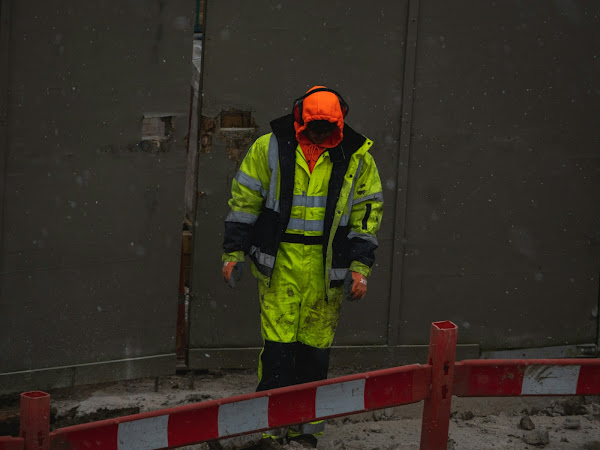Workwear clothing has a rich history that spans centuries, evolving from purely functional attire to becoming a significant part of fashion culture. From its origins in agricultural and industrial settings to its current status as a style statement, workwear has undergone significant transformations influenced by industrialization, societal changes, and fashion trends.
Featured Photo by Caspar Rae on Unsplash
This article delves into the fascinating journey of workwear clothing, exploring its origins, evolution of functionality, impact of industrialization, trends through the decades, the intersection of workwear and fashion, and its role in contemporary culture.
Origins of Workwear Clothing
- Early Workwear in Agricultural and Industrial Settings
Back in the day, workwear wasn't just about fashion - it was about getting the job done without ruining your Sunday best. From the fields to the factories, workwear served a practical purpose in protecting workers from the elements and potential hazards. Think sturdy overalls, durable denim, and practical aprons - all essential gear for a hard day's work.
- Evolution of Workwear Functionality
- Innovation in Fabric and Design
- Specialized Workwear for Different Professions
As time marched on, workwear got a makeover. Innovative fabrics like duck canvas and denim brought durability to the forefront, while smart design features like reinforced knees and multiple pockets catered to specific job requirements. Suddenly, workwear wasn't one-size-fits-all - it was tailored to meet the needs of various professions, from carpenters to mechanics, with style and functionality in mind.
- Impact of Industrialization on Workwear
- Standardization of Workwear in Mass Production
- Health and Safety Regulations in Workwear
With the rise of mass production during the Industrial Revolution, workwear underwent a transformation. Standardized sizing and mass-produced uniforms became the norm, ensuring efficiency on the production line. Additionally, health and safety regulations started to influence workwear design, with features like high-visibility strips and flame-resistant fabrics becoming essential for hazardous work environments.
Workwear Trends Through the Decades
- Influence of War and Global Events on Workwear Styles
- The Rise of Workwear as Fashion Statement
From the trenches of World War I to the Rosie the Riveter era of World War II, global events shaped workwear trends. Practicality met style as workwear evolved into a fashion statement, with iconic pieces like denim jeans and bomber jackets crossing over from the factory floor to the runway. Today, workwear continues to be a symbol of utility and style, blending the best of both worlds for the modern worker.Workwear and Fashion: Blurring the Lines
- Crossover of Workwear Elements into High Fashion
Workwear clothing has seamlessly transitioned from being purely functional to a fashion statement. Elements like sturdy denim, utilitarian pockets, and durable fabrics have found their way from the worksite to the runway, proving that style and practicality can indeed go hand in hand.
Collaborations between Workwear Brands and Designers
The worlds of workwear brands and high-end fashion designers have collided in a beautiful symphony of creativity. Collaborations between iconic workwear labels and visionary designers have resulted in collections that blend rugged functionality with cutting-edge aesthetics, creating pieces that are both stylish and functional.
- The Role of Workwear in Contemporary Culture
- Social and Environmental Awareness in Workwear Choices
In today's socially conscious world, the choices we make in our clothing reflect our values. Workwear brands that prioritize sustainable materials, ethical production practices, and fair labor conditions are gaining popularity as consumers seek clothing that not only looks good but also does good for the planet and the people.
Workwear as a Symbol of Identity and Lifestyle
More than just a practical necessity, workwear has become a symbol of individual identity and lifestyle. From rugged enthusiasts embracing the heritage of classic workwear styles to urban trendsetters putting a modern twist on traditional pieces, what we wear to work is now a reflection of who we are and what we stand for.
In conclusion, the history of workwear clothing is a testament to the resilience and adaptability of fashion in response to changing societal needs and cultural influences. From humble beginnings as practical garments for laborers to iconic pieces that blur the lines between work and leisure attire, workwear continues to hold a significant place in our wardrobes and collective identity. As we look towards the future, the evolution of workwear will undoubtedly continue to reflect the values and aspirations of modern society, further intertwining functionality with style in innovative and inspiring ways.
Frequently Asked Questions
1. What distinguishes workwear clothing from regular clothing?
Workwear clothing is designed with specific job functions or industries in mind, focusing on durability, functionality, and protection. It often features reinforced stitching, pockets for tools, and specialized fabrics to withstand harsh conditions.
2. How has workwear influenced mainstream fashion?
Workwear has made a significant impact on mainstream fashion, with elements like denim, utility jackets, and steel-toed boots becoming staples in many wardrobes. Designers often draw inspiration from workwear aesthetics to create trendy and functional pieces for everyday wear.
3. Are there sustainable options available in the workwear industry?
Yes, the workwear industry has been incorporating sustainable practices and materials to reduce environmental impact. Brands are increasingly offering eco-friendly workwear options made from recycled materials, organic cotton, and other sustainable fabrics.
4. How can I incorporate workwear elements into my everyday style?
You can easily incorporate workwear elements into your everyday style by mixing traditional workwear pieces like utility pants or rugged boots with more casual or trendy items. Layering, accessorizing with belts or hats, and experimenting with textures can also help blend workwear into your personal style seamlessly.


No comments:
Post a Comment